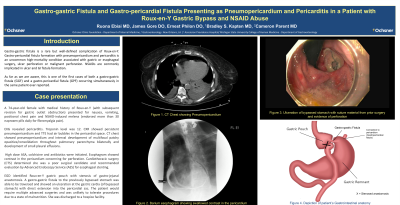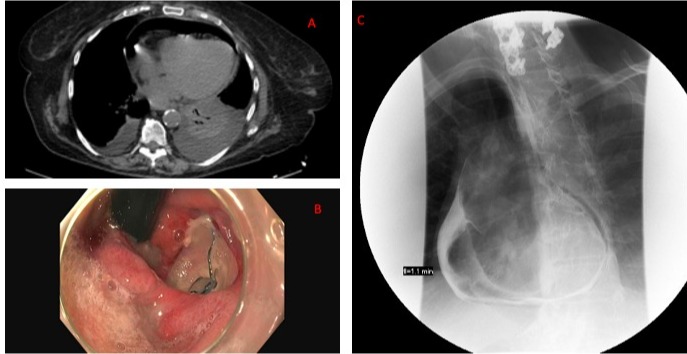Sunday Poster Session
Category: Stomach
P1383 - Gastro-gastric Fistula and Gastro-pericardial Fistula Presenting as Pneumopericardium and Pericarditis in a Patient with Roux-en-Y Gastric Bypass and NSAID Abuse
Sunday, October 22, 2023
3:30 PM - 7:00 PM PT
Location: Exhibit Hall

Has Audio

Ruona Ebiai, MD
Ochsner Clinic Foundation
New Orleans, LA
Presenting Author(s)
Award: Presidential Poster Award
Ruona Ebiai, MD1, James Gore, DO1, Ernest Philon, DO1, Bradley S. Kapten, MD2, Cameron Parent, MD1
1Ochsner Clinic Foundation, New Orleans, LA; 2Ascension Providence Hospital/ Michigan State University College of Human Medicine, Southfield, MI
Introduction: Gastrogastric fistula is a rare but well-defined complication of Roux-en-Y. Gastropericardial fistula formation with pneumopericardium and pericarditis is an uncommon high-mortality condition associated with gastric or esophageal surgery, ulcer perforation or malignant perforation. NSAIDs are commonly implicated in ulcer and GI fistula formation. As far as we are aware, this is one of the first cases of both a gastrogastric fistula (GGF) and a gastropericardial fistula (GPF) occurring simultaneously in the same patient ever reported.
Case Description/Methods: A 74 year-old female with medical history significant for Roux-en-Y and protein-calorie malnutrition presented for nausea, vomiting, positional chest pain and NSAID-induced melena (endorsed more than 30 naproxen pills daily for fibromyalgia pain). Her EKG revealed pericarditis and blood test had troponin level of 12. A CXR showed persistent pneumopericardium and TTE had air bubbles in the pericardial space. CT demonstrated continued pneumopericardium and interval development of multifocal patchy opacities/consolidation throughout pulmonary parenchyma bilaterally and development of small pleural effusions. High dose ASA, colchicine and antibiotics were initiated. Esophagram showed contrast in the pericardium concerning for perforation. Cardiothoracic surgery (CTS) determined she was a poor surgical candidate and recommended evaluation by Advanced Endoscopy Service (AES) for esophageal stenting. EGD identified Roux-en-Y gastric pouch with stenosis of gastrojejunal anastomosis. A gastro-gastric fistula to the previously bypassed stomach was able to be traversed, and showed an ulceration at the gastric cardia (of bypassed stomach) with direct extension into the pericardial sac. The patient would require multiple advanced surgeries and was unlikely to tolerate procedures due to a state of malnutrition. She was discharged to a hospice facility.
Discussion: This case highlights the complexities associated with surgically-altered gastrointestinal anatomy. A connection between gastric pouch and bypassed stomach and co-occurring connection between bypassed stomach and pericardium is extremely unlikely to be diagnosed by clinical or radiographic findings alone. In patients with multiple risk factors such as age, history of gastric bypass with anastomotic ulceration and NSAID usage, index of suspicion for a GI based etiology should be high when pneumopericardium is discovered.

Disclosures:
Ruona Ebiai, MD1, James Gore, DO1, Ernest Philon, DO1, Bradley S. Kapten, MD2, Cameron Parent, MD1. P1383 - Gastro-gastric Fistula and Gastro-pericardial Fistula Presenting as Pneumopericardium and Pericarditis in a Patient with Roux-en-Y Gastric Bypass and NSAID Abuse, ACG 2023 Annual Scientific Meeting Abstracts. Vancouver, BC, Canada: American College of Gastroenterology.
Ruona Ebiai, MD1, James Gore, DO1, Ernest Philon, DO1, Bradley S. Kapten, MD2, Cameron Parent, MD1
1Ochsner Clinic Foundation, New Orleans, LA; 2Ascension Providence Hospital/ Michigan State University College of Human Medicine, Southfield, MI
Introduction: Gastrogastric fistula is a rare but well-defined complication of Roux-en-Y. Gastropericardial fistula formation with pneumopericardium and pericarditis is an uncommon high-mortality condition associated with gastric or esophageal surgery, ulcer perforation or malignant perforation. NSAIDs are commonly implicated in ulcer and GI fistula formation. As far as we are aware, this is one of the first cases of both a gastrogastric fistula (GGF) and a gastropericardial fistula (GPF) occurring simultaneously in the same patient ever reported.
Case Description/Methods: A 74 year-old female with medical history significant for Roux-en-Y and protein-calorie malnutrition presented for nausea, vomiting, positional chest pain and NSAID-induced melena (endorsed more than 30 naproxen pills daily for fibromyalgia pain). Her EKG revealed pericarditis and blood test had troponin level of 12. A CXR showed persistent pneumopericardium and TTE had air bubbles in the pericardial space. CT demonstrated continued pneumopericardium and interval development of multifocal patchy opacities/consolidation throughout pulmonary parenchyma bilaterally and development of small pleural effusions. High dose ASA, colchicine and antibiotics were initiated. Esophagram showed contrast in the pericardium concerning for perforation. Cardiothoracic surgery (CTS) determined she was a poor surgical candidate and recommended evaluation by Advanced Endoscopy Service (AES) for esophageal stenting. EGD identified Roux-en-Y gastric pouch with stenosis of gastrojejunal anastomosis. A gastro-gastric fistula to the previously bypassed stomach was able to be traversed, and showed an ulceration at the gastric cardia (of bypassed stomach) with direct extension into the pericardial sac. The patient would require multiple advanced surgeries and was unlikely to tolerate procedures due to a state of malnutrition. She was discharged to a hospice facility.
Discussion: This case highlights the complexities associated with surgically-altered gastrointestinal anatomy. A connection between gastric pouch and bypassed stomach and co-occurring connection between bypassed stomach and pericardium is extremely unlikely to be diagnosed by clinical or radiographic findings alone. In patients with multiple risk factors such as age, history of gastric bypass with anastomotic ulceration and NSAID usage, index of suspicion for a GI based etiology should be high when pneumopericardium is discovered.

Figure: A. CT with pneumopericardium B. Gastropericardial fistula with ulceration seen via retroflexion of scope as scope passes gastro-gastric fistula with suture material from prior surgery and evidence of perforation C. Esophagram with contrast in the pericardium
Disclosures:
Ruona Ebiai indicated no relevant financial relationships.
James Gore indicated no relevant financial relationships.
Ernest Philon indicated no relevant financial relationships.
Bradley Kapten indicated no relevant financial relationships.
Cameron Parent indicated no relevant financial relationships.
Ruona Ebiai, MD1, James Gore, DO1, Ernest Philon, DO1, Bradley S. Kapten, MD2, Cameron Parent, MD1. P1383 - Gastro-gastric Fistula and Gastro-pericardial Fistula Presenting as Pneumopericardium and Pericarditis in a Patient with Roux-en-Y Gastric Bypass and NSAID Abuse, ACG 2023 Annual Scientific Meeting Abstracts. Vancouver, BC, Canada: American College of Gastroenterology.

